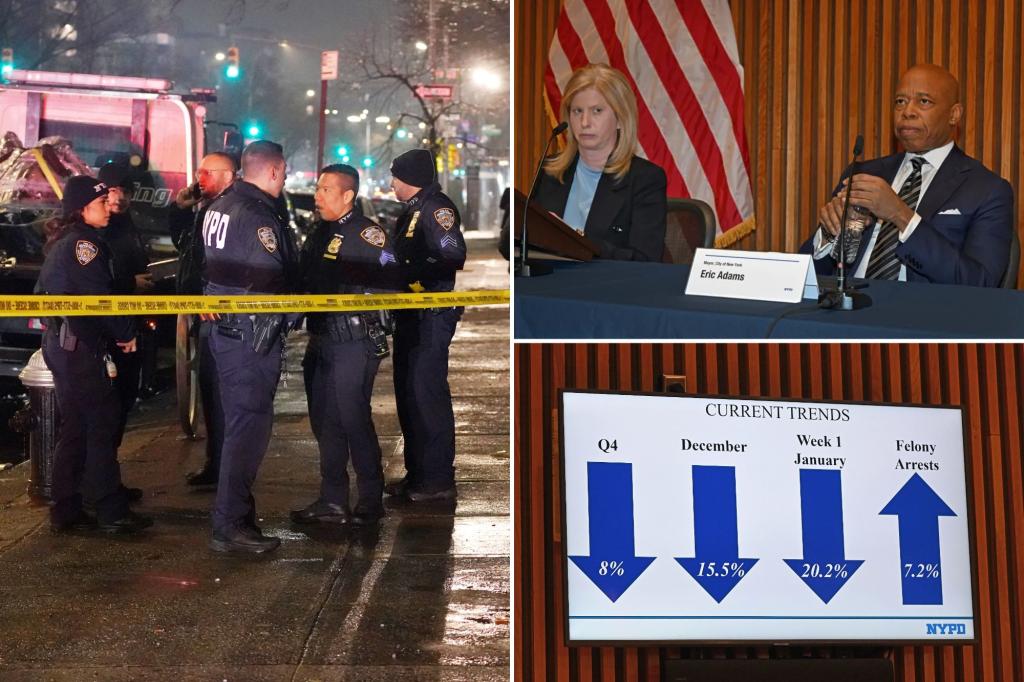The New York City Police Department (NYPD) reported a significant decrease in major crimes during January 2025, offering a glimmer of hope for a city grappling with public safety concerns. The overall crime rate for the seven major categories, including murder, robbery, and felony assault, plummeted by 16.8% compared to the same period in 2024. This positive trend comes as Mayor Eric Adams prepares to present his budget testimony before the state legislature, providing him with a much-needed victory amidst a challenging political landscape. The substantial drop in crime offers a platform for Adams to highlight his administration’s commitment to public safety and counter narratives that question the effectiveness of his policies.
A closer examination of the NYPD’s statistics reveals encouraging declines across several key crime categories. Murders decreased by a substantial 24%, dropping from 33 in January 2024 to 25 in January 2025. Robberies also saw a significant reduction of 26%, falling from 1,436 to 1,063. Felony assaults, a crucial indicator of violent crime, decreased by 6.9%, from 2,130 to 1,983. Property crimes also experienced declines, with burglaries dropping by 3.7% and grand larceny decreasing by a notable 21.7%. Grand larceny auto, a persistent problem in the city, also saw a significant reduction of 23.1%. These figures collectively paint a picture of improved safety across various facets of city life.
However, amidst this largely positive trend, reported rapes presented a stark contrast, increasing by a concerning 40% from 106 in January 2024 to 149 in January 2025. City officials attributed this rise to a new state law implemented in September 2024, which broadened the definition of rape to include forced oral and anal sex, alongside vaginal penetration. While this legislative change aims to provide a more comprehensive understanding of sexual assault, it also impacts the statistical reporting of these crimes, potentially creating the appearance of a surge where one may not exist in actuality. Further analysis will be needed to determine the true impact of this legal change on the incidence of sexual assaults in the city.
Beyond the city streets, positive trends were also observed in transit and public housing crime statistics. Transit crimes experienced a substantial plunge of 36.4%, falling from 231 incidents in January 2024 to 147 in January 2025. This decrease comes after significant investments in subway policing, including the deployment of 1,200 additional officers. Major incidents in public housing developments also declined, albeit by a smaller margin of 14.5%, from 497 to 425. These improvements in specific areas suggest that targeted policing strategies may be yielding positive results. However, sustained efforts will be crucial to maintain these downward trends.
Mayor Adams, facing re-election later this year amidst a challenging political climate, including a criminal corruption trial and declining approval ratings, seized upon the positive crime statistics to bolster his administration’s image. He emphasized the connection between public safety and prosperity, arguing that the January figures demonstrate the effectiveness of his comprehensive approach to crime reduction. Adams touted the double-digit decreases in both overall crime above ground and transit crime below ground, while also highlighting the lowest number of shooting incidents recorded for the month of January in over 30 years. This strategic messaging aims to reassure residents concerned about safety and project an image of effective leadership.
Furthermore, Adams credited the NYPD and its leadership for their dedication and hard work in making the streets safer. He explicitly contrasted his administration’s support for the police with calls for defunding the police, framing his approach as aligned with the desires of New Yorkers who, in his view, prefer increased police presence. This rhetoric reflects a broader political debate about the role of law enforcement in maintaining public safety, with Adams positioning himself firmly on the side of increased policing. This stance is likely to resonate with a segment of the population concerned about rising crime, but it also risks alienating those who advocate for police reform and alternative approaches to public safety.

